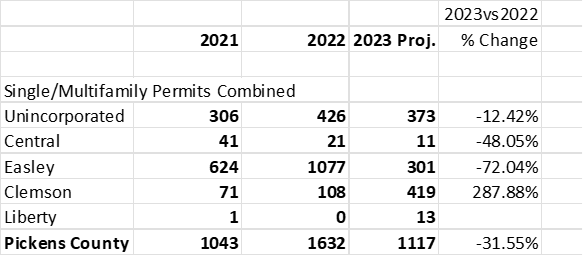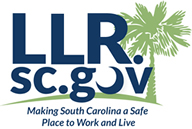Hello REALTORS®,
Last week, I shared with you building permit data across the Upstate. Overall, building permits are up 16.5% since 2018, although they seem to have leveled off after the crazy year—2021. In fact, it looks like 10,000 to 11,000 new housing starts across the six Upstate counties is the new normal, about the same as 2006.
But what does it look like inside the various counties. Two of the counties in the Western Upstate, Anderson and Pickens, report building permit data by city (Anderson County only reports for the City of Anderson). Oconee County does not report by city, but county level totals are in the last graph in this Watchdog Report.
Pickens County
Pickens County has had a moratorium in place on new subdivisions for a year. That moratorium, along with potentially less dense zoning regulations, a new impact fee, and strong opposition to high-density housing in Easley have significantly reduced housing production in Pickens County. Easley took the biggest hit—down 72% mostly in the multifamily segment. Meanwhile, housing production in Clemson jumped almost 300 percent, although one-third of Clemson’s new housing were duplexes, triplexes, and quadplexes.

Anderson County
Demand for housing, when denied by one county, will try to go somewhere else. Some demand may be going to Oconee County, which has a couple of new subdivisions under construction. And some of it has gone to Anderson County. New housing has trended higher in Anderson County since 2018 when 1,000 new housing units were permitted.

Sprawl?
The Upstate has been on the front line of anti-growth politics since the housing market rebounded from the Great Recession. But that’s not new—opposition to new housing just picked up where it left off in 2007. The hot spots are Greenville County and eastern Pickens and Anderson counties.
Unfortunately, the result can be sprawl. And the building permit data indicates that sprawl is a growing problem in the Upstate. Greenville County has gradually increased its production, but as a percentage of the Upstate, it has fallen back—the same for Spartanburg County. Meanwhile, housing production in Anderson, Pickens, and Laurens counties have all increased as a percentage of the region. That’s how sprawl happens.

Forecast Luncheon is on February 15
Data helps us in advocacy. I hope it can help you in your business planning as well. That is why your Western Upstate Association of REALTORS® will host Laura Ullrich, Regional Economist with the Federal Reserve Bank of Richmond, as our guest speaker at our Forecast Luncheon on February 15. Mark your calendar and watch the Weekly Update for more details.
Support RPAC
RPAC is an important element of your Realtors Association’s advocacy program. I encourage you to support RPAC and we make it easy to do so—we include a voluntary RPAC contribution on your annual dues renewal. Simply pay it and you have support RPAC. If you want to do more, it’s easy.
Michael Dey, Director of Government Affairs



